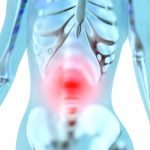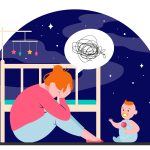Polarity Analysis Homeopathy: Two Women’s Health Cases
TIM SHANNON, ND, DHANP
I began my naturopathic studies at NUNM (then called “NCNM”) in 1996. Several years prior to starting my naturopathic education, I became intrigued with homeopathy. I recall several NCNM teachers describing homeopathy in miraculous, though daunting, terms. In addition, it was common to hear instructors almost proudly proclaim that only after 10 years of rigorous study could you be beyond the “beginner” realm. I recall another instructor saying that the practice of homeopathy is more demanding than being a neurologist or a brain surgeon.
The available homeopathy research was considerably less robust at that time compared to now.1,2 Even though many students were initially beguiled by some of homeopathy’s potential, it appeared that only the true “homeo geeks” hung in there and ended up using homeopathy as a prime modality. This is understandable, given the paucity of research back then (1996), its seeming implausibility, and the repeated pronouncements that homeopathy is so difficult to learn.
Needless to say, I was one of those homeopathy geeks. Like many of my peers, I too assumed that homeopathy was inherently extremely challenging. It is an exceptionally demanding discipline, and to use it effectively requires years of hard work to reach competency. Looking back, it isn’t hard to understand why many naturopathic students don’t choose homeopathy as their specialty.
Nevertheless, I opened my practice in Portland, OR, in 2001, primarily practicing homeopathic medicine for mental health challenges. Over many years, I worked hard at practice and continuous study of homeopathy. At one point in my career, I felt burned out on the modality. I pursued IV therapy and began practicing general naturopathic medicine. Homeopathy became increasingly rare in my practice. In addition, my family and I moved from Portland up to Olympia, WA, to join a naturopathic clinic – where I continue to practice today.
Polarity Analysis
Roughly 4 years ago, I read about a small (n=62) double-blind, crossover ADHD trial of homeopathy.3 It indicated that by using polarity analysis (PA) homeopathy, one can potentially achieve a greater than 80% success rate with ADD/ADHD children. That success rate is akin to conventional medicine’s success rate using stimulants.
Such a success rate for a natural healing modality was impressive. In my almost-20-year career as a naturopathic doc, I have never heard of any other form of treatment that could compete with conventional ADHD medications in terms of efficacy. This study made me pause, and thus began my study of PA homeopathy.
I began using it more and more frequently in my practice, and now it is all I use. Both the ease of using it and the incredible success rate it can afford convinced me to start teaching this method as well. I am convinced it is the form of homeopathy best suited for naturopathic doctors, functional med doctors, and other providers.
Polarity Analysis is the brainchild of Dr Heiner Frei, a Swiss pediatrician. The bulk of contemporary homeopathy is based on the repertory of James Tyler Kent. In 2001, Dr Frei built a sort of “smart system” wrapped around an unusual repertory that he had been using for 30 years. Originally written by Baron von Boenninghausen in 1846, it was later revised by several others. However, Polarity Analysis uses the revision by Gypser et al (2000). Boenninghausen’s Therapeutic Pocketbook4 is a small (roughly 130 remedies) and rarely used repertory in the United States.
In brief, Frei’s goal in developing PA homeopathy was to improve precision in homeopathic prescribing by reconciling contradictions. Since many remedies cover opposite symptoms (eg, heat aggravates/heat ameliorates) but in differing grades (eg, 4/1), polarity differences are calculated. The higher the polarity difference, the more likely a remedy corresponds to the patient’s symptom.
Using this method with statistical rigor, Dr Frei has continually refined and improved the method using both retroactive and prospective studies of patients from his practice.5-7 Most of his studies demonstrate a consistent success rate of roughly 80% for a broad range of clinical challenges. He has conducted studies on acute infections, the 2010-2011 H1N1 epidemic, multi-morbid chronic disease, ADHD, and others. He has also written 2 excellent texts explaining how to use his system.8,9
Case Study 1
A 51-year-old woman presented to my office with menopausal hot flashes, painful bladder spasms, and chronic urinary tract infections (UTIs) accompanied by dysuria and frequency. This patient, who was referred by a colleague, had her initial intake on January 19, 2018.
“I’m here for repeated UTIs and kidney stones,” she said. “I had a UTI this past September. I tested positive for Group B strep and was given antibiotics. Unfortunately, I had an anaphylactic reaction to the first antibiotic I was given. The second one caused me to break out in hives.
“When I urinate, it’s like my whole bladder is spasming. When I release to urinate, it feels like a spasm. It also burns, but only at the end of urination.”
I asked her how she was being treated for these issues. “My urologist prescribed a med for bladder spasm. I took it this morning; it helps immensely.
“The current episode started about 3 or 4 days ago. I get these bad episodes of bladder infections with symptoms 4 times a year. This has been recurrent for roughly 5 years. Over the last few days, I’ve been feeling nauseous.”
I asked her about hot flashes. “They are day and night – clearly worse at night.”
Workup & Treatment
I developed a baseline of subjective symptoms in order to better follow the patient across encounters.
- UTIs (long-term): a minimum of 4 times per year
- Bladder spasm (current): multiple times per day
- Burning at the end of urination: multiple times per day
- Frequent urination
- Hot flashes day and night, worse at night: occur in 2 or 3-week cycles
I conducted a PA repertorial analysis with the patient (Figure 1).
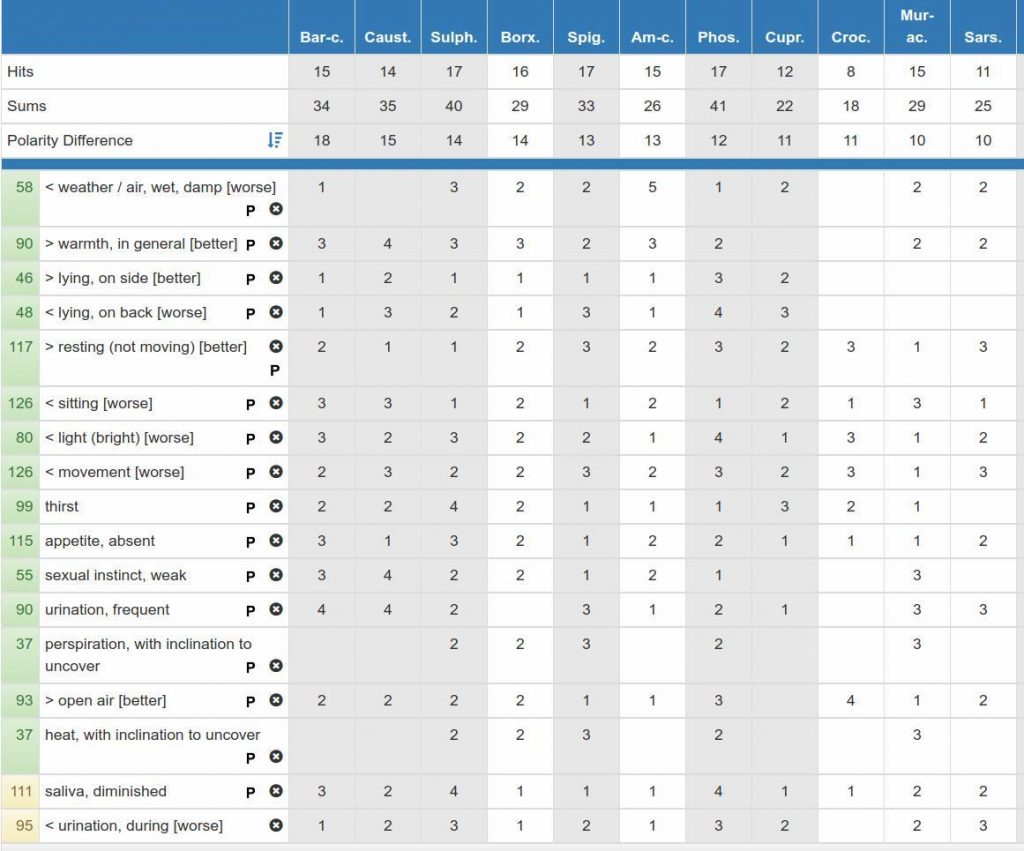
Assessment & Recommendation: With confirmations in the materia medica for bladder symptoms as well as hot flashes, I recommended that the patient take Ammonium carbonicum 6C, given in a 1-oz dropper bottle (20/80, ethanol/water), 4 sublingual drops daily.
Follow-up Visits
Follow-up, January 26, 2018
When I asked how she was doing, she said, “The bladder is better. There are still some spasms, but the pain is resolved. For the last few days, my low back has hurt. My urine is strong-smelling. My cold symptoms are getting better since seeing you last, too. I do feel way better. It’s helped with the bladder spasms; they aren’t half as bad as they were.”
I asked the patient about her baseline symptoms. Because this was only 1 week into treatment, it was too early to assess any change in the UTI frequency. The bladder spasms had improved: “That’s better. I no longer have spasms right when I release urine. Before, it would spasm as I was running to the bathroom. That has resolved.” The burning at the end of urination was now absent. I asked her about the daily and nightly hot flashes: “I had hot flashes for 5 years, and they’re gone. They stopped within a day or so of starting your prescription.” The only symptom that was unchanged was the urinary frequency/urgency.
Assessment & Recommendation: The patient appeared to be responding well for most symptoms. I recommended she take the drops up to 2 or 3 times per day as needed.
Follow-up, April 13, 2018
The patient reported, “I was without the tincture for 4 or 5 days, and my hot flashes were raging! Definitely works for that. I’m taking it 2 or 3 times a day; sometimes I take it 4 times. It was super bad without the drops, so I immediately started them up again – zoom, no flashes! It’s funny – I’ve noticed that even with smoking, I can’t smoke as much.”
So far, she had not experienced any UTIs. The bladder spasm was now gone. Burning at the end of urination was still absent. Hot flashes were much improved. Feelings of anxiety, frustration, irritability, and a sense of “being wound up” – which were added to the symptom list on February 16th and rated as 4-5/10 in severity – were no longer occurring on a daily basis. When I asked her about frequent urination, she said, “I’m on a diuretic because of hypercalcemia. I’ve had kidney stones – 2 in my right kidney – which are still there.”
Assessment & Recommendation: The patient was continuing to do well. I suggested she continue for now with the same regimen.
Follow-up, July 13, 2018
When I asked the patient how she was doing, she said, “I’ve been off the tincture for 1 ½ months. I weaned myself off; I wanted to see how my bladder reacted. I’ve not had any problems whatsoever. I have a step-daughter who’s nothing but a pain in the ass – very high-maintenance. I’ve been doing wonderfully with the anxiety despite her antics – amazing, really.”
She had still not had another UTI. The bladder spasms, burning at the end of urination, and the hot flashes had all resolved. I asked her about her feelings of anxiety, frustration, and irritability. “That flared up recently due to my step-daughter. But it’s better now – more like a 2/10.” The urinary frequency was still present, but she felt this was because of the diuretic she was taking for kidney stones.
Assessment & Recommendation: The patient was happy with the outcome. I recommended she take a final dose of Ammonium carbonicum, in a 200C potency. According to a chart review in October 2020, she has had no recurrence of hot flashes, bladder symptoms, or any UTIs since her last visit.
Case Study 2
A 35-year-old woman presented to my office on March 13, 2020 with hot flashes, menorrhagia, fatigue, low libido, and hyperhidrosis.
Her opening statement was, “I’m here because my hormones are raging.” I asked her if she was taking any prescription medications, and she said no. She denied any family history of disease, but added, “My mom had a surgical menopause. Many people in my family have had thyroid issues.” I asked her about menarche and her menstrual history. “I started menstruating at age 12. I’ve had no issues with periods except for some dysmenorrhea between age 18 and 19. I was put on birth control to solve it. The birth control really made me crazy and feel ‘not myself.’ I got off them, and haven’t been on them since.”
I asked her about current symptoms. She replied, “I’m always hot, worse when I wake up in the morning. I feel like I’m burning from the inside out; I have to go outside and sit in the cold. I’m also gaining weight, but I’ve not done anything different. I have been cutting out gluten and wheat, but I’m still gaining weight. I’m not fat, but I’m not at the size I’m used to. I also feel puffy. My periods are very heavy; I’ve never had such heavy periods. In the middle of the night, I go to standing up, and then I leave a trail from bed to bathroom. The heavy flow also has clots now. Also new is having body odor. I’ve never had these problems before! For more than a year now, it’s been like this.”
I asked her about pregnancies [the patient has 3 children]. “It felt like the pregnancies threw my body out of whack. With the first baby, I went from 120 up to 200 pounds. Every pregnancy caused major weight gains, and then I lost a lot too. I wondered how my system handled it.” I asked her if there were any other changes. “Yes, nausea. Also, I’m normally quite constipated, but I stopped gluten in October and reduced grains. Now I’ve been going every day; this is huge for me.” She denied any major changes in her life, stressors, or health complaints around the onset of these symptoms. “Nothing stands out; all of this came on out of the blue.”
Workup & Treatment
Her baseline symptoms were as follows:
- Morning hot flashes: 3 mornings per week
- Heavy flow with every period
- Fatigue: daily
- Low libido
- Profuse sweating day and night (axillary)
- Night-time hot flashes: 2 times per week
Assessment & Recommendation: I decided to check blood levels of her sex hormones, cortisol, and DHEA-sulfate (DHEA-S). Everything came back as normal, except the DHEA-S, which was elevated at 384.4 µg/dL (normal, 45-270 µg/dL).
I also conducted a PA repertorial analysis with the patient (Figure 2), and I gave her Iodatum LM1, 4 drops every other day. I saw her again 10 days later. She had no response to the remedy. I subsequently reviewed the analysis, and after reading the materia medica, I gave her Secale cornutum Ø. I put 1 drop of the mother tincture in a 1-oz dropper bottle, and had her take 4 sublingual drops 1-2 times per day, depending on need. I asked her to return in 2 weeks for a follow-up.
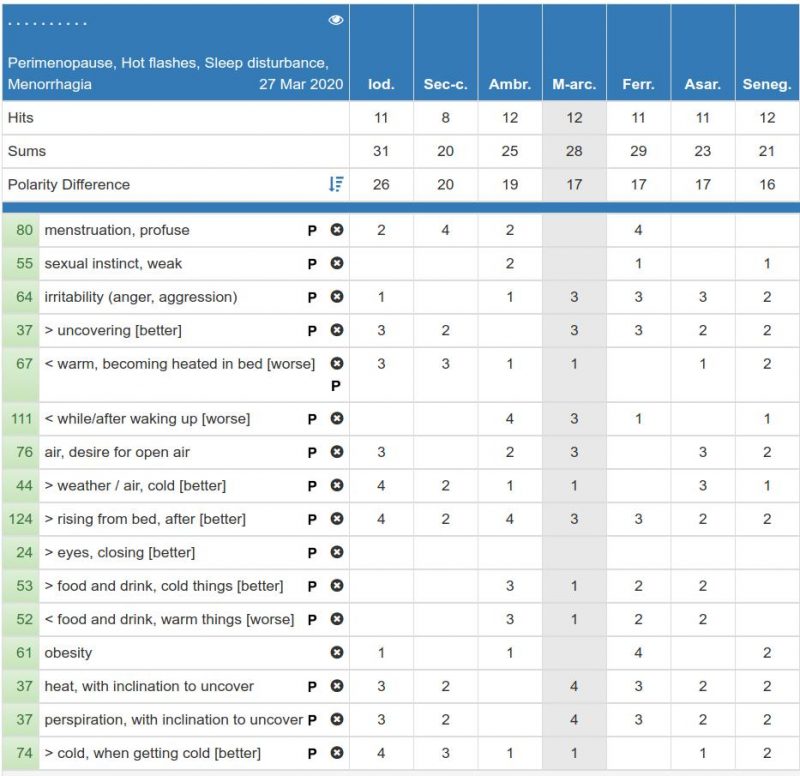
Follow-up Visits
Follow-up, April 17, 2020
The patient had been taking the remedy 2 times per day. I asked her about the hot flashes. She said, “I haven’t had any… or that burning inside. In fact, I haven’t had a hot flash since starting your new prescription on March 27th.”
I asked her about her baseline symptoms. Both the morning and night-time hot flashes had resolved. The profuse sweating had improved. It was too early to tell about the heavy flow with her periods. She still experienced daily fatigue. When I asked her about her low libido, she replied, “No change.”
Assessment & Recommendation: Some of the patient’s symptoms appeared to be responding to Secale. However, I thought it might be easier to take it once a day. I started the patient on Secale 6C, 4 drops daily. I suggested that she return in 4-6 weeks.
Follow-up, June 17, 2020
The patient reported, “The tincture has worked awesome for my symptoms. But it made me depressed and weepy. I stopped it after 3 or 4 weeks of taking it. After stopping, those symptoms resolved. It helped with many things; I still haven’t had a hot flash.” I asked her how soon after stopping did the “Crazies” go away? “It was a week at the most,” she replied.
Then she said, “There is something else we didn’t discuss previously. I feel I run around in circles and don’t finish anything. I get overwhelmed. That’s not how I used to be. I feel like I know the things I need to do, I know the ways I need to get them accomplished. But I never accomplish them; I just put it off. I have all these ideas of how to do it great, but ultimately I end up doing little of what needs getting done.”
I asked her about her baseline symptoms. Morning and night-time hot flashes were still resolved. The profuse sweating was continuing to improve. I asked her about the fatigue. She said, “It’s better, but not back to normal – maybe 20% better.” There was still no change in her libido.
Two new symptoms were added to the list:
- Irritability: every 1-2 days
- Overwhelm/procrastination: every 1-2 days
Assessment & Recommendation: Secale put an end to several symptoms (notably the hot flashes, hyperhidrosis and, to a limited degree, the fatigue). More work was needed. I conducted a PA repertorial analysis with the patient (Figure 3). Based on the results, I prescribed Sepia 3C daily. I recommended a follow-up visit in 4 to 6 weeks.
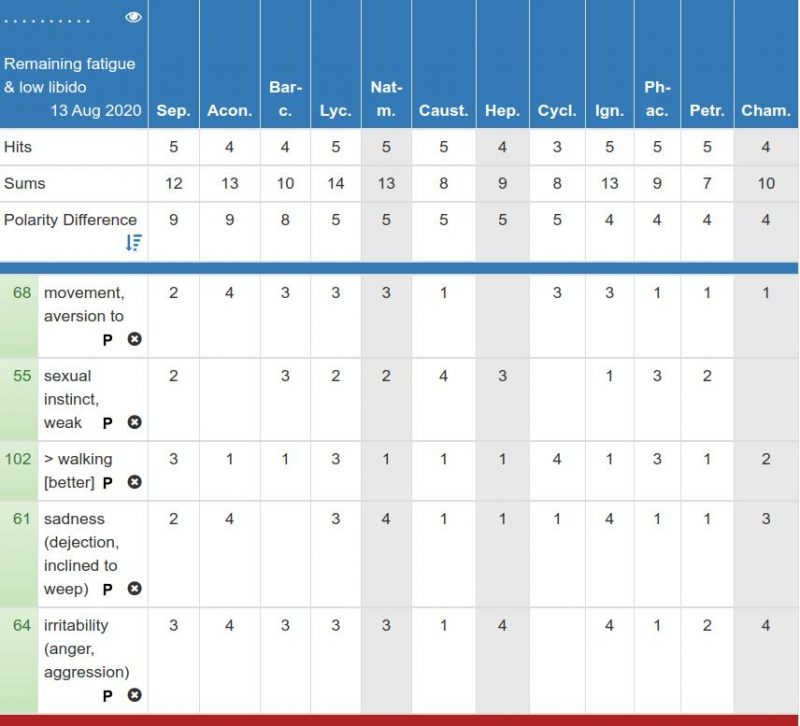
Follow-up, July 9, 2020
When I asked the patient how she was doing, she said, “I feel back to my normal self. I’m not so jumpy and irritable. I haven’t had any hot flashes, which is awesome! I feel good. I started feeling better within a week of taking the remedy.”
Her daily fatigue had mostly resolved. The irritability had also resolved, and the sense of overwhelm and procrastination was “definitely better.” When I asked her about her menses, she said, “So far, the heavy flows have resolved. Now I’m back to my normal heavy flow, no longer leaking all over!” The only symptom that hadn’t budged was her low libido.
Assessment & Recommendation: It appeared that Sepia had been a successful follow-up remedy to Secale. Because of the persistently low libido, I recommended she take a daily dose of Sepia 30C. The goal here was to see if Sepia at a higher potency would spur changes in this last remaining symptom. It would also likely help resolve any further remaining symptoms that were not yet fully back to normal. I recommended a follow-up visit in mid-October to sort this out.
Follow-up, October 16, 2020
I asked the patient if taking the Sepia on a daily basis had helped with the libido. “It’s better, for sure,” she replied. When I asked her if she had any remaining health concerns, she said that she’d been gaining a lot of weight. I asked her what her current weight was. “I’m normally 125 pounds, but now I’m up to 145. I was starting to gain weight when we first started working together, but I’ve continued to gain.”
Assessment & Recommendation: All presenting symptoms have resolved except for the weight gain. I recommended that she reduce the homeopathic Sepia to 4 drops 2 times per week and gradually taper off. I also counseled her in depth about the possibility that intermittent fasting might be a good fit and might help to reverse the weight gain trend. We will follow up in 2 months to determine if further treatment is needed for the weight issue.
Note: A follow-up DHEA-S measurement, on October 27, 2020, was 312 µg/dL (down from 384.4 µg/dL in March). Although still elevated, it’s clearly moving in the right direction.
References:
- Homeopathy Research Institute. Essential Evidence. 2020. Available at: https://www.hri-research.org/resources/essentialevidence/. Accessed September 25, 2020.
- American Institute of Homeopathy. Homeopathy Research Evidence Base: References. American Institute of Homeopathy. Last updated December 9, 2019. Available at: https://homeopathyusa.org/uploads/Homeopathy-Research-Evidence-Base-12-13-2019.pdf. Accessed September 25, 2020.
- Frei H, Everts R, Von Ammon K, et al. Homeopathic treatment of children with attention deficit hyperactivity disorder: A randomised, double blind, placebo controlled crossover trial. Eur J Pediatr. 2005;164(12):758-767.
- Gypser KH, ed. Bönninghausen’s Therapeutic Pocketbook. Revised edition. Stuttgart, Germany: Sonntag Verlag; 2000.
- Frei H. H1N1 Influenza: A Prospective Outcome Study with Homeopathy and Polarity Analysis. 2014. Am J Homeopath Med. Available at: https://static1.squarespace.com/static/520f6c38e4b01b013b22f419/t/5506937ae4b0edf4bca410b4/1426494330156/H1N1+AJHM+E.pdf. Accessed September 25, 2020.
- Frei H. Homeopathic treatment of multimorbid patients: a prospective outcome study with polarity analysis. Homeopathy. 2015;104(1):57-65. Available at: https://static1.squarespace.com/static/520f6c38e4b01b013b22f419/t/550693cce4b015246aa6aa89/1426494412568/MMP%2C+HomE+2015.pdf. Accessed September 25, 2020.
- Frei H, Thurneysen A. Homeopathy in acute otitis media in children: treatment effect or spontaneous resolution? Br Homeopath J. 2001;90(04):180-182.
- Frei H. Polarity Analysis in Homeopathy: A Precise Path to the Simillimum. Kandern, Germany: Narayana Verlag GmbH; 2013.
- Frei H. Homeopathy and ADHD. Kandern, Germany: Narayana Verlag GmbH; 2015.

Tim Shannon, ND, DHANP specializes in cancer care, mental health, anti-aging therapy, men’s health, and general wellness. His approach to cancer includes supportive care for patients receiving conventional treatment, and alternative treatment for cancer patients when conventional treatments are inappropriate or unwanted. Dr Shannon’s primary modality is a type of classical homeopathy called Polarity Analysis. He also teaches the Polarity Analysis. In addition, his treatment plans emphasize diet and lifestyle changes when appropriate. For recreation, Dr Shannon enjoys hiking, roller blading, family bike trips, Qigong, and general family time.





